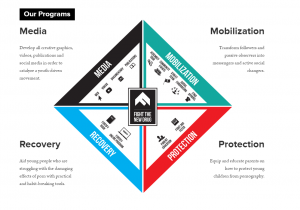
Fight the New Drug’s message is clear — the shirts that read “Porn Kills Love” and “Become a Fighter” make it obvious the organization won’t back down until society recognizes the harmful effects of pornography.
Fight the New Drug, a new, secular anti-pornography organization, will be hosted on the BYU campus by the newly revitalized BYU Unraveling Pornography Club.
Fight the New Drug is an anti-pornography nonprofit organization that operates in Salt Lake City. The organization plans to visit BYU to give a lecture on the harmful effects of pornography using science, facts and personal stories. Members from the organization will speak on Nov. 14 at 2 p.m. in the Joseph Smith Building auditorium.
Students can learn about Fight The New Drug’s mission to raise awareness of the addictions of pornography and how they can make a difference worldwide and on campus by attending the lecture. They can also join the BYU Unraveling Pornography Club.
Unraveling Pornography Club president Andrew Dixon believes the lecture will be helpful because Fight The New Drug discusses the taboo subject in a revolutionary way.
“They (the members working for Fight the New Drug) have real experience in the war for morality,” he said. “We have much to learn from them and how we can join the fight against pornography.”
The club has been advertising the event by making announcements to classes, chalking the sidewalks and ramps that lead to campus and distributing posters.
Clay Olsen, a Logan native and the co-founder and executive director of Fight The New Drug, said BYU has supported the group’s mission from the beginning. He said the conversation needs to take place on more than just BYU’s campus.

“We know that this is an issue that affects all university campuses regardless of strong religious affiliations,” Olsen said. “We believe that because our generation is the first generation to deal with the issue of pornography to this intensity and scale, we have the responsibility to help our society pursue real love and reject its hollow counterfeit.”
The speakers at the lecture this week will discuss how pornography acts as a drug and harms in three areas: the brain, relationships and society. Olsen said they would also be talking about redefining what it means to be anti-porn and how students can get involved in the movement.
On the Fight the New Drug website, facts explain that pornography harms the brain because it fills the brain with dopamine, the same chemical substance that occurs when someone partakes of other addictive substances. The repeated flood of dopamine changes the brain’s reward pathway and changes the viewer’s brain altogether.
Relationships are harmed by pornography because it can cause the viewer to feel less attracted to their partner.
“When a person frequently uses pornography, they’re far more likely to feel less satisfied with their partner’s looks, sexual performance and willingness to try new sexual acts,” the website said.
Society is damaged by pornography because it can lead to violence. Fight The New Drug explains on its site that “watching violent porn changes attitudes and leads viewers to think violent sex is normal.”
Olsen said Fight the New Drug offers help to those trying to recover from pornography addiction through its online program, Fortify.

“As we present our message, not only do we educate teens on the harmful effects of pornography, but we also give them a place to turn for help, when so many are silently struggling and are too ashamed or embarrassed to reach out to an adult,” Olsen said.
He said Fight the New Drug has an all-inclusive approach with the movement. “We carry our anti-pornography message across borders of religion, political beliefs and social backgrounds by presenting it as a public health issue, rather than as a moral, political or religious argument,” Olsen said.
Religious-centered help is available through The Church of Jesus Christ of Latter-Day Saints, which also combats pornography and owns a site devoted to overcoming the addiction through the Atonement of Jesus Christ.
The Church’s site, OvercomingPornography.org, offers advice for individuals as well as for spouses, families and church leaders who want to support their loved one’s recovery.
Help is available for those who seek it, and Fight the New Drug is a major source of that strength. Fight the New Drug and the LDS Church both have valuable resources that can help break addictions and free users of guilt.
Sidebar:
Fight The New Drug operates through four programs of attack, which are outlined on its website.
- Media: The team develops creative documentaries, videos, graphics and publications and social media to “catalyze a youth-driven movement.”
- Mobilization: The transformation of idle followers to active messengers and social changers who spread the news that porn kills love.
- Recovery: Help is available through Fight The New Drug, and those struggling with pornography are given help through habit-breaking tools.
- Protection: The program focuses on educating parents on protecting their children from pornography and providing them the tools to do so.




